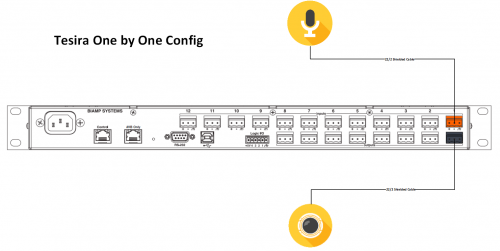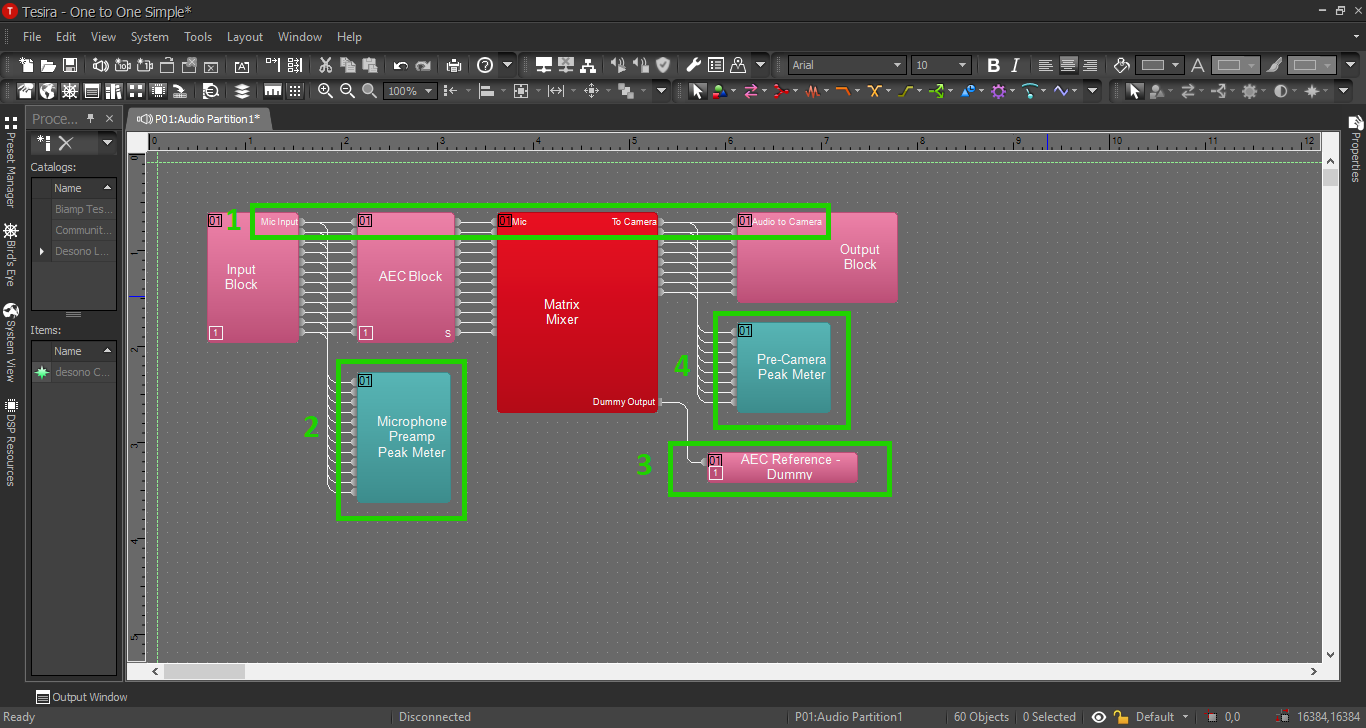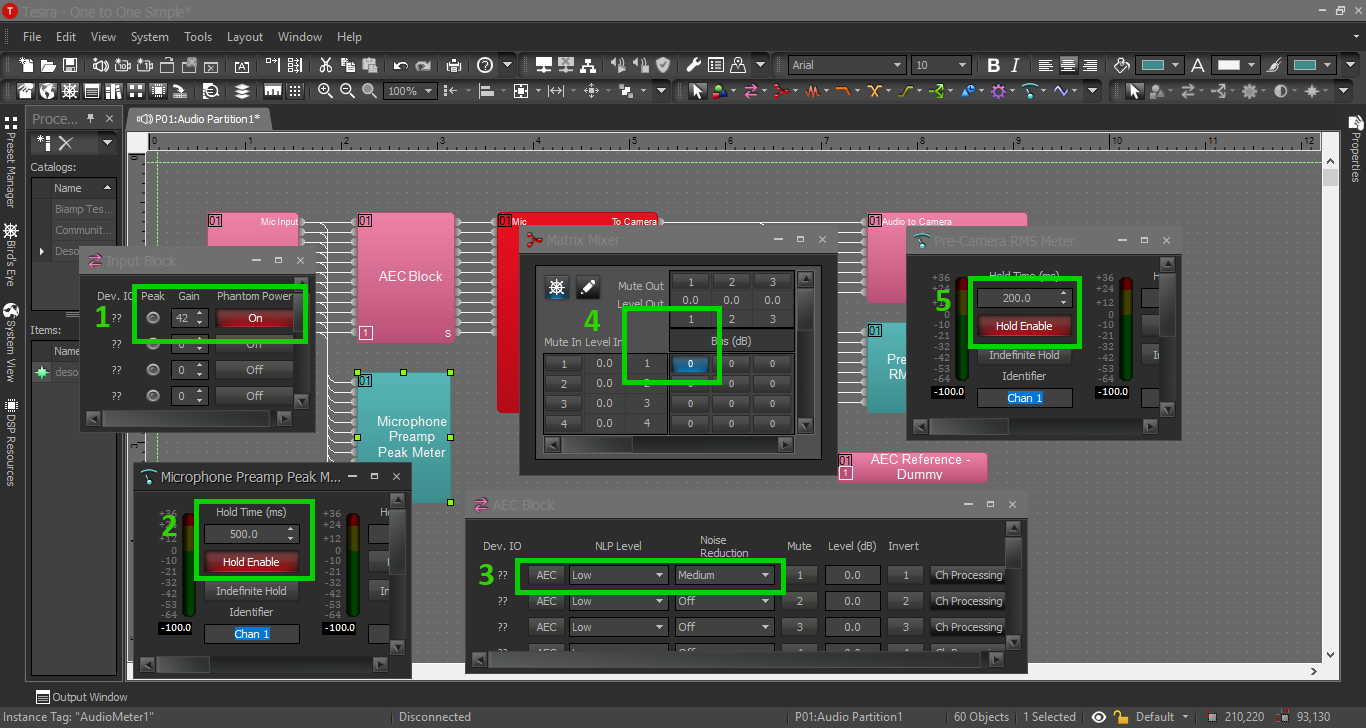Difference between revisions of "Simple Configuration"
IVSWikiBlue (talk | contribs) |
IVSWikiBlue (talk | contribs) |
||
| Line 15: | Line 15: | ||
#* Matrix Mixer with at least 1 input and 1 output, with one extra output | #* Matrix Mixer with at least 1 input and 1 output, with one extra output | ||
#Connect the blocks as follows: | #Connect the blocks as follows: | ||
| − | #* The Tesira Input block will already be connected to the AEC block, so connect the first peak meter to the Input block. | + | #* The Tesira Input block will already be connected to the AEC block, so connect the first peak meter to the Input block. This will help us to be sure we have the proper levels set on the preamp. More on that in a minute. |
#* Connect the AEC block to the Matrix Mixer. | #* Connect the AEC block to the Matrix Mixer. | ||
| − | #* Connect output 1 from the mixer to port 1 on the Tesira Output block | + | #* Connect output 1 from the mixer to port 1 on the Tesira Output block AND to the second peak meter. This way we can make sure to reach the right audio levels before we send it to the camera. |
| − | #* Connect the extra output from the Matrix Mixer to the AEC reference. | + | #* Connect the extra output from the Matrix Mixer to the AEC reference. We will not need to activate the Automatic Echo Cancellation feature in this example. However, Tesira will not allow us to delete the AEC reference block for some reason. It also will not compile the configuration if any blocks are not connected (including the AEC reference block.) So, I’d recommend using an extra output from the mixer as a "dummy output channel. We will not send any audio to this channel. |
| Line 28: | Line 28: | ||
==Processing Blocks in Tesira== | ==Processing Blocks in Tesira== | ||
| − | + | This section will provide further thought process behind each processing block, and how to adjust settings. | |
| − | |||
| − | |||
| − | |||
| − | |||
| − | |||
| − | |||
| − | |||
[[File:One Simple Blocks.png]] | [[File:One Simple Blocks.png]] | ||
| − | #We will not use STM-1’s to power the mics – the Forte will provide phantom power. Enable it here for | + | #We will not use STM-1’s to power the mics – the Forte will provide phantom power. Enable it here for each mic. The gain control on the input block is our preamp. I find for MX202’s the preamp will usually end up being between 42-48 dB. A preamp is what allows us to boost the audio signal without added noise, so this setting is important. Our goal is for the level of normal speech to show up at or around 0 dB on the peak meter. |
| − | # | + | #Speaking of which, here is our peak meter, which will help us set our input gain to the proper level. As a default though, it will give us an instantaneous reading, which is much too fast to be helpful to us. Select a time between 250-500 milliseconds and enable the Hold button. When we are testing our input gain, we should aim to be peaking around 0dB, “kissing” the yellow. Loud noises such as a door slamming should peak way in the yellow, but not clip the input (not surpass the red section of the meter.) |
| − | #The AEC Block does all the processing for noise reduction in the Forte. If we were going to use AEC in our solution, we would activate the AEC button here. | + | #The AEC Block does all the processing for noise reduction in the Forte. If we were going to use AEC in our solution, we would activate the AEC button here. This block also includes general noise reduction capabilities (the Noise Reduction setting). I find that Medium is usually the best option for a room mic. |
#Our matrix mixer is how we decide where to send the audio signal of the mic(s). On the left the mixer shows the inputs, and on the top it displays the outputs. In this example, since we have one mic and sending it to one camera, we simply enable the matrix box corresponding to input 1 and output 1. | #Our matrix mixer is how we decide where to send the audio signal of the mic(s). On the left the mixer shows the inputs, and on the top it displays the outputs. In this example, since we have one mic and sending it to one camera, we simply enable the matrix box corresponding to input 1 and output 1. | ||
#Press Enable Hold again on the peak meter at the end of our chain. Since we did not use any processing in this example, the levels of the peak meters should match. When we have more complex solutions, this will help us verify our levels and verify that we have configured the mixer properly. | #Press Enable Hold again on the peak meter at the end of our chain. Since we did not use any processing in this example, the levels of the peak meters should match. When we have more complex solutions, this will help us verify our levels and verify that we have configured the mixer properly. | ||
Revision as of 15:12, 21 April 2020
Contents
Description/Objective
In this example, we will be connecting one microphone to one camera and using the Tesira Forte DSP to reduce the amount of white noise.
Wiring/Line Diagram
We can really use whichever inputs and outputs we’d like, so let’s use input 1 and output 1 to keep things simple. When we terminate our cables, the mic will go into Orange Input 1 and the audio line to the camera will go into Black Output 1.

Tesira Software
Connections
- Once you've completed your physical connections, open the Tesira software and start building your configuration.
- In this configuration we'll be using the following blocks. Add these blocks to your configuration:
- TesiraFORTE CI block
- Peak Meter x 2
- Matrix Mixer with at least 1 input and 1 output, with one extra output
- Connect the blocks as follows:
- The Tesira Input block will already be connected to the AEC block, so connect the first peak meter to the Input block. This will help us to be sure we have the proper levels set on the preamp. More on that in a minute.
- Connect the AEC block to the Matrix Mixer.
- Connect output 1 from the mixer to port 1 on the Tesira Output block AND to the second peak meter. This way we can make sure to reach the right audio levels before we send it to the camera.
- Connect the extra output from the Matrix Mixer to the AEC reference. We will not need to activate the Automatic Echo Cancellation feature in this example. However, Tesira will not allow us to delete the AEC reference block for some reason. It also will not compile the configuration if any blocks are not connected (including the AEC reference block.) So, I’d recommend using an extra output from the mixer as a "dummy output channel. We will not send any audio to this channel.
When you're complete, your file should look something like this:
Processing Blocks in Tesira
This section will provide further thought process behind each processing block, and how to adjust settings.
- We will not use STM-1’s to power the mics – the Forte will provide phantom power. Enable it here for each mic. The gain control on the input block is our preamp. I find for MX202’s the preamp will usually end up being between 42-48 dB. A preamp is what allows us to boost the audio signal without added noise, so this setting is important. Our goal is for the level of normal speech to show up at or around 0 dB on the peak meter.
- Speaking of which, here is our peak meter, which will help us set our input gain to the proper level. As a default though, it will give us an instantaneous reading, which is much too fast to be helpful to us. Select a time between 250-500 milliseconds and enable the Hold button. When we are testing our input gain, we should aim to be peaking around 0dB, “kissing” the yellow. Loud noises such as a door slamming should peak way in the yellow, but not clip the input (not surpass the red section of the meter.)
- The AEC Block does all the processing for noise reduction in the Forte. If we were going to use AEC in our solution, we would activate the AEC button here. This block also includes general noise reduction capabilities (the Noise Reduction setting). I find that Medium is usually the best option for a room mic.
- Our matrix mixer is how we decide where to send the audio signal of the mic(s). On the left the mixer shows the inputs, and on the top it displays the outputs. In this example, since we have one mic and sending it to one camera, we simply enable the matrix box corresponding to input 1 and output 1.
- Press Enable Hold again on the peak meter at the end of our chain. Since we did not use any processing in this example, the levels of the peak meters should match. When we have more complex solutions, this will help us verify our levels and verify that we have configured the mixer properly.

